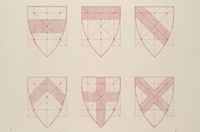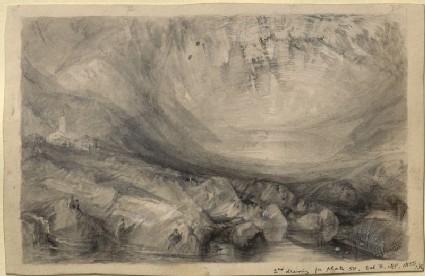Ruskin's revision to the Rudimentary series (1878)
Unpublished manuscript catalogue for proposed re-organisation of the Rudimentary series.

Ruskin's Catalogues: 1 object
Show search help- Reference URL
Actions
Drawing of Turner's "Goldau" John Ruskin
-
Ruskin text
116.I give place next to another of the drawings executed for Modern Painters because the method of execution used in it, pencil washed with neutral tint, will enable the student often to obtain memoranda of chiaroscuro for which pencil alone would be too weak, and sepia too coarse. The drawing also represents, better than the engraving, the general effect of Turner’s Sunset seen from Goldau, so frequently alluded to in my lectureswritings .
-
Curator’s description:
Description
According to Cook and Wedderburn (XXI.305), the Supplementary Cabinet was 'a cabinet which Ruskin placed in the School but did not fill'; the examples which they listed were placed there shortly before their catalogue was published in 1906.
-
Details
- Artist/maker
-
John Ruskin (1819 - 1900)after Turner (Joseph Mallord William Turner) (1775 - 1851)
- Object type
- drawing
- Material and technique
- pen and ink, watercolour and bodycolour over graphite on off-white wove paper
- Dimensions
- 138 x 215 mm
- Associated place
-
- Europe › Switzerland › Schwyz › Goldau › Goldau (subject)
- Inscription
- Recto:
within the image, bottom right, in ink: J. Ruskin | 1855
in the border, top, left of centre, in graphite: L
in the border, top right, in graphite: [...]
in the border, bottom right, in ink: 2nd drawing 1n plate 50. Vol. 4 MP. 1855. | J.R
Verso, all in graphite:
top left, recent: ? Sup 171.
bottom, left of centre: Bottom
just left of and below centre, and right of and below centre, two impressions of the Ruskin School's stamp
- Provenance
-
Presumably presented by John Ruskin to the Ruskin Drawing School (University of Oxford); first recorded in the Ruskin Drawing School in 1878; transferred from the Ruskin Drawing School to the Ashmolean Museum c.1949
- No. of items
- 1
- Accession no.
- WA.RS.SUP.171
-
Subject terms allocated by curators:
Subjects
-
References in which this object is cited include:
References
Taylor, Gerald, ‘John Ruskin: A Catalogue of Drawings by John Ruskin in the Ashmolean Museum, Oxford’, 7 fascicles, 1998, Oxford, Ashmolean Museum, no. 053
Ruskin, John, ‘Rudimentary Series 1878’, 1878, Oxford, Oxford University Archives, cat. Rudimentary no. 116
Ruskin, John, ‘The Ruskin Art Collection at Oxford: Catalogues, Notes and Instructions’, Edward T. Cook and Alexander Wedderburn, eds, The Works of John Ruskin: Library Edition, 39 (London: George Allen, 1903-1912), 21, cat. Supplementary no. 171
Location
-
- Western Art Print Room
Ruskin's Catalogues
-
Ruskin's revision to the Rudimentary series (1878)
116.I give place next to another of the drawings executed for Modern Painters because the method of execution used in it, pencil washed with neutral tint, will enable the student often to obtain memoranda of chiaroscuro for which pencil alone would be too weak, and sepia too coarse. The drawing also represents, better than the engraving, the general effect of Turner’s Sunset seen from Goldau, so frequently alluded to in my lectureswritings .





